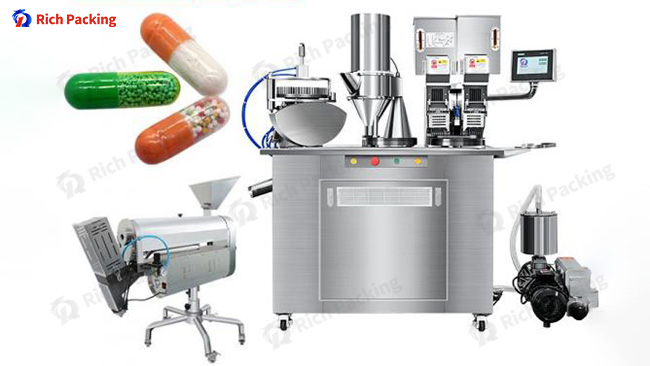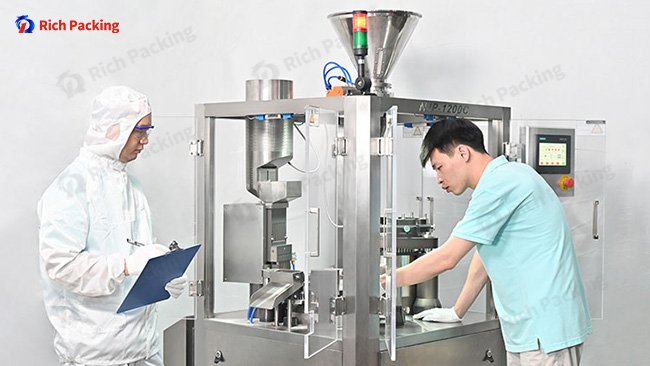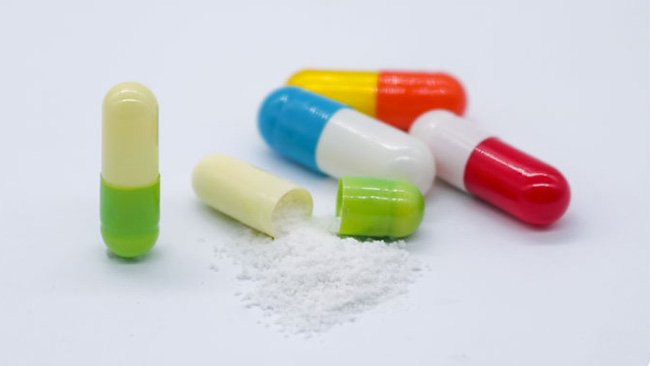A capsule filling machine can completely change the way you work. Instead of spending hours filling capsules by hand, the right machine lets you produce more capsules, with more consistent doses, in much less time. Whether you are making capsules for yourself, running a small online supplement brand, or managing production in a nutraceutical or pharmaceutical plant, choosing the right capsule filler is a big decision.
This guide breaks down the critical decisions:
● The main types of capsule fillers
● the pre-purchase questions to ensure you make the right choice
● core considerations for your decision
● how to match your machine to your needs and growth plans.
Before you compare technical specs, it helps to be clear about why you want a capsule making machine first.
Common situations include:
● Personal or household use
You want to make your own herbal blends, vitamins, or special formulations for yourself, family, or clients.
● Small brand, clinic, or lab
You sell small batches of supplements online or in a clinic, or you run a lab or compounding room that needs regular but modest production.
● Nutraceutical or pharmaceutical manufacturing
You already run (or plan to run) a production line for commercial products and need a reliable, compliant way to fill hard capsules at scale.
The good news is: there is a capsule filling machine for each of these stages. The challenge is matching your current needs and future plans to the right level of equipment.

We will begin with an overview of the three primary capsule filler types available on the market.
A manual capsule filler is essentially a simple tool that helps you align, open, fill, and close capsules by hand.
● How it works
You pour empty capsules into a tray or plate, shake to align them, separate caps and bodies, spread your powder, tamp it down, and then press the caps back on.
● Who it’s for
o Individuals making their own supplements
o Small clinics or practitioners preparing custom blends
o Labs and formulators doing very small trial batches
● Advantages
o Low cost and compact size
o No electricity needed
o Easy to learn and use
● Limitations
o Slow: usually only a few hundred capsules per session
o Labor-intensive and repetitive
o Difficult to scale beyond a certain volume
If your main goal is personal use or very occasional small runs, a manual capsule filler will likely meet all your needs.
2. Semi-Automatic Capsule Filler Machines – A Bridge to Small-Scale Production
By merging manual control with automated filling, semi-automatic machines offer a balance of efficiency and precision.
● How it works
Operators load and align capsules, and the machine takes over key steps such as separating caps and bodies, filling, tamping, and closing. Some steps remain manual, but throughput and consistency improve dramatically.
● Who it’s for
o Small supplement brands
o Labs and hospital pharmacies making regular batches
o Businesses moving beyond “side project” volume
● Advantages
o Much higher output than purely manual methods (often thousands of capsules per hour)
o More consistent fill weights and appearance
o Lower operator fatigue compared to full manual work
● Limitations
o Still requires 1–2 operators actively involved
o Cleaning, changeover, and setup require some training
o Needs a dedicated space and stable power supply
If you have regular orders and want to keep production in-house without the cost and complexity of a full automatic line, a semi automatic capsule filler can be an ideal step.

Automatic capsule machines are built to handle high-volume, industrial-scale production.
● How it works
The machine automatically feeds empty capsules, separates caps and bodies, fills the bodies with product, compacts, rejects defective units, closes the capsules, and discharges finished capsules continuously.
● Who it’s for
o Nutraceutical factories
o Pharmaceutical manufacturers
o Contract manufacturing organizations (CMOs/CDMOs)
● Advantages
o High output: tens of thousands of capsules per hour
o Stable, repeatable dosing and quality
o Minimal manual handling; ideal for integration with capsule polishing, counting, bottling, or blister lines
● Limitations
o Higher investment cost
o Requires experienced operators and maintenance support
o Needs more space, utilities, and a robust production environment
If you are building or expanding a commercial production line, an fully automatic capsule filling machine becomes the heart of your capsule operation.
Five Key Questions to Guide Your Buying Decision
To efficiently narrow your focus to the right machine category, begin with these five questions before analyzing technical specifications and pricing.
● Personal / household / clinic use
You probably don’t need industrial speed. A manual or very small semi automatic machine may be enough.
● Small brand, lab, or shop
You are selling products, even if volumes are modest. Semi automatic machines start to make sense.
● Nutraceutical or pharma factory
Production volume, traceability, and compliance are key. You should be thinking mainly about automatic capsule filling machines and complete lines.
Try to convert your needs into capsules per hour or capsules per day:
● How many bottles or packs do you want to produce per day?
● How many capsules are in each bottle?
● How many working hours per day do you have?
From there, you can see roughly which range you fall into:
● A few hundred capsules per day → manual or very small semi automatic
● A few thousand per day → semi automatic or entry-level automatic
● Tens of thousands per day → full automatic
Different materials behave differently inside a capsule filler:
● Powders – the most common; flowability can vary greatly
● Granules or pellets – may require special dosing systems
● Oils or suspensions – need dedicated liquid-filling technology
If your material is:
● very light and fluffy,
● sticky or oily, or
● prone to absorbing moisture,
you should discuss this specifically with potential capsule machine suppliers. Some machines handle challenging powders better than others. For complex materials, test runs or detailed technical discussion are often worth the time.
● If your use is personal, clinic, or small-scale and will stay that way, choose a machine that comfortably covers your current needs without over-investing.
● If you expect to grow your business, think about a machine that gives you some room to increase volume, or a clear upgrade path (for example: starting with semi automatic now, planning to move to automatic later).
Buying the cheapest machine possible only to replace it a year later can be more expensive than choosing a slightly more capable model upfront.
● For personal users, the question is:
Are you willing to spend time learning the proper way to operate and clean the equipment?
● For small brands and labs:
Do you have one or two people who can become “machine owners”, responsible for daily operation, cleaning, and basic troubleshooting?
● For factories:
Do you have maintenance and engineering support, and are your operators comfortable with HMI panels, parameters, and alarms?
A capsule machine you “can afford but cannot really run” is not a good investment.

Once you understand your situation, it’s time to look at the factors that actually define the right machine for you.
Manufacturers often advertise maximum output in capsules per hour. But the number that matters is the practical speed you can run day after day, considering your product, quality checks, and changeovers.
Ask yourself:
● What output do I really need per hour/day?
● How much time will I lose to setup, cleaning, and changeovers?
● Do I need a machine that can run below its maximum speed but stay very stable?
For personal and small-scale users, output is often a convenience issue. For factories, it directly affects delivery times and unit cost.
Most capsule fillers are compatible with a broad range of capsule sizes, typically from 000 to 5. But not all machines support all sizes out of the box, and changing sizes may require different tooling.
Check:
● Which sizes you plan to use now and in the future
● Which sizes the machine can handle, and what change parts are required
● the machine compatible with both gelatin and vegetarian capsules (e.g., HPMC) ?
If you plan to expand your product range, choosing a machine with flexible size and material options can save you future headaches.
Even two powders that look similar can behave very differently in a dosing system.
Consider:
● Flowability: does it pour easily, or does it clump and bridge?
● Particle size: fine, coarse, or mixed?
● Oil content: very dry or somewhat oily?
● Sensitivity: does it easily absorb moisture or degrade with heat?
These properties affect:
● how evenly capsules are filled,
● how often blockages or stoppages occur, and
● how much dust you have to manage.
When in doubt, describe your material honestly to the supplier and ask how similar products have been handled on their machines.
This is frequently overlooked parts of capsule machine selection.
● For personal or small users, cleaning needs to be straightforward and not take half a day.
● For multi-SKU factories, long changeovers can seriously reduce real capacity.
Ask:
● How many components must be disassembled for a thorough clean?
● Are product-contact parts easy to access and reassemble?
● How long does a typical product changeover take in practice?
● Are there clear cleaning and maintenance instructions?
A machine that is easier to clean and maintain will often deliver more usable output over its lifetime than a machine that is slightly faster but difficult to deal with.
Even if you “only” make dietary supplements, safety and hygiene matter a lot.
Look for:
● Guarding and interlocks on moving parts
● Emergency stop buttons in reachable positions
● Overload protection and clear alarms
● Hygienic design in product-contact areas (smooth surfaces, minimal crevices, good seals)
If you plan to pass audits or work with more demanding customers or channels in the future, it’s wise to consider GMP-friendly design and documentation from the beginning.
It’s easy to focus only on the purchase price, but a capsule filling machine has ongoing costs:
● Installation and training
● supplies, lubricants, and spare parts
● Operator labor and supervision
● Electricity and, for some automatic capsule encapsulation machine, compressed air
● Downtime cost when the machine is not running
A cheap machine that jams, is difficult to clean, or wastes powder will ultimately cost you more than a reliable, well-built one.

Manual vs Semi Automatic vs Automatic: A Quick Comparison
To help you see the big picture, here’s how the three categories compare in broad terms.
● Manual
o A few hundred to maybe a thousand capsules per session
o Best for personal use and very small batches
● Semi automatic
o Typically thousands of capsules per hour
o Good for regular small and medium-sized batches
● Automatic
o Tens of thousands of capsules per hour
o Intended for continuous, large-scale production
● Manual
o Very simple to understand
o Requires patience and repetitive manual work
● Semi automatic
o Needs one or two trained operators
o Requires basic understanding of the machine, dosing, and cleaning
● Automatic
o Needs trained operators and support from maintenance/engineering
o More parameters, alarms, and mechanical systems to understand
● Personal / household / clinic
o Usually stay with manual capsule fillers
o Occasionally move to very small semi automatic units if volume grows
● Small brands / labs
o Often start with semi automatic machines
o Upgrade to automatic machines when one or more products reach high volume
● Factories
o May use semi automatic machines for pilot and niche products
o Rely on automatic capsule fillers as the core of their main production lines
Now that you’ve seen the options and key factors, it’s time to tie everything together.
● A manual capsule filler machine is usually enough.
● Focus on:
o Ease of use and cleaning
o Capsule size compatibility
o Reasonable capacity for your weekly or monthly needs
Only consider a small semi automatic machine if your volume and budget clearly justify it.
● A semi automatic capsule filling machine is often the best starting point.
● Focus on:
o Output that fits your orders and growth plans
o Changeover and cleaning time, especially if you have multiple SKUs
o Training and basic support from the machine supplier
When one or more products start to demand continuous production, it may be time to plan for a fully automatic machine.
If You Are a Nutraceutical Factory, CMO, or Pharmaceutical Manufacturer
A fully automatic encapsulating machine should be your main focus.
● Consider it as one node in your entire production line, not an isolated purchase.
● Focus on:
o Long-term capacity, OEE, and stability
o Integration with upstream and downstream equipment
o GMP design, documentation, and validation support
o Service, spare parts, and training from the supplier
A Short Checklist Before You Talk to Suppliers
Before you ask for quotations, it helps to have clear answers to:
● How many capsules do we need to produce per hour/day/month—now and in 2–3 years?
● What capsule sizes and shell materials will we use?
● What are the main characteristics of our formulas and powders?
● How often will we change products, and how critical is cleaning time?
● What safety, hygiene, and compliance requirements must we meet?
● What is our realistic budget and payback expectation?
With these answers in hand, you can have a much more productive conversation with potential suppliers and quickly see which capsule filling machine truly fits your needs.
The goal is not to buy the most impressive machine on paper, but the one that matches your scale, your products, and your team—and can support your plans for the next few years without holding you back.